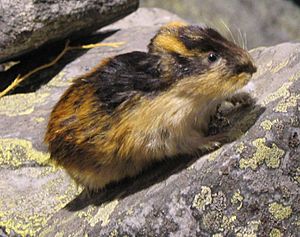Lemming facts for kids
Quick facts for kids Lemming |
|
|---|---|
 |
|
| Lemmus lemmus | |
| Scientific classification | |
| Kingdom: | |
| Phylum: | |
| Class: | |
| Order: | |
| Family: | |
| Subfamily: |
Arvicolinae
|
| Tribe: |
Lemmini
|
| Genera | |
|
Dicrostonyx |
|
Lemmings are small, furry rodents that look a bit like hamsters. They live in very cold places, mostly in or near the Arctic. You can find them in wide, treeless areas called tundras.
Contents
What Are Lemmings Like?
Lemmings are often called the "rats and mice" of the Arctic because they are so common there. They have very short tails and are usually brown or gray. These little animals are well-suited for their cold homes.
Where Lemmings Live
Lemmings spend their summers living underground in burrows they dig. These burrows help them stay safe from predators. When winter comes, the ground freezes solid, so they can't dig anymore. Instead, they live under the thick blanket of snow. The snow acts like an igloo, keeping them warm and hidden.
What Lemmings Eat
Lemmings are herbivores, meaning they eat plants. Their main diet includes grasses, mosses, and the roots of plants. They spend a lot of time searching for food, especially in the harsh Arctic environment.
The Lemming Life Cycle
Lemmings are famous for their amazing population changes. Their numbers can go up and down a lot over a few years.
Reproduction and Population Booms
When there is a lot of food available, lemmings have many babies. A single female lemming can have several litters (groups of babies) in a year. This means their population can grow very quickly. In years with plenty of food, millions of lemmings might be found roaming the tundra!
When lemming numbers are high, predators like owls and foxes have more than enough to eat. This also helps the predators have more babies, as there's so much food around.
The Search for Food
However, the tundra doesn't have enough food for millions of lemmings forever. As their numbers grow, they start to run out of food and space. This makes them restless, and they begin to search widely for new places to live and eat.
Many lemmings will start to move, looking for a new home. Soon, huge numbers of lemmings follow each other across the Arctic landscape. During these journeys, many lemmings are caught by foxes and owls. Some might even drown if they try to swim across rivers or lakes.
Population Decline
Eventually, the lemming population drops. The lemmings that survive these journeys find enough food and space to live comfortably. Then, the cycle starts all over again, with their numbers slowly growing until the next big boom. This natural cycle helps keep the Arctic ecosystem balanced.
See also
 In Spanish: Leminos para niños
In Spanish: Leminos para niños

